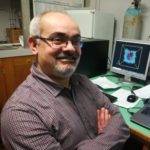Using biological cells as source of electrical energy
Content of the lecture:
- Structure and function of the plasmamembrane sourrounding biological cells
- Ion transport through the plasmamembrane and the generation of an electrical potential difference across it
- Viewing and modeling the electrical properties of the plasma membrane as an electrical RC circuit
- Techniques allowing to establish an electrical contact with the cell interior
- Using biological cells as self rechargeable batteries
- Estimation of the power that can be harvested from a biological cell
- Storing energy harvested from a biological cell and using it to send a wireless signal
Teacher: Dr. Luigi Catacuzzeno
 Dr Catacuzzeno is a researcher in Physiology at the Department of Chemistry, Biology, and Biotechnology, University of Perugia. Its research activity has been mostly focused on the electrical properties of biological cells. More specifically most of his studies deals with membrane proteins called ion channels, that allows the transport of ions across the plasmamembrane and create charge separation across it. Part of his activity has been dedicated to biophysical studies of the structure/function relationship of these proteins, and part to the study of pathophysiological consequences of their dysregulation. His research has been mainly conducted using the patch-clamp technique to study ion channel activity and excitability, and programming in C language for theoretical models/predictions.
Dr Catacuzzeno is a researcher in Physiology at the Department of Chemistry, Biology, and Biotechnology, University of Perugia. Its research activity has been mostly focused on the electrical properties of biological cells. More specifically most of his studies deals with membrane proteins called ion channels, that allows the transport of ions across the plasmamembrane and create charge separation across it. Part of his activity has been dedicated to biophysical studies of the structure/function relationship of these proteins, and part to the study of pathophysiological consequences of their dysregulation. His research has been mainly conducted using the patch-clamp technique to study ion channel activity and excitability, and programming in C language for theoretical models/predictions.
